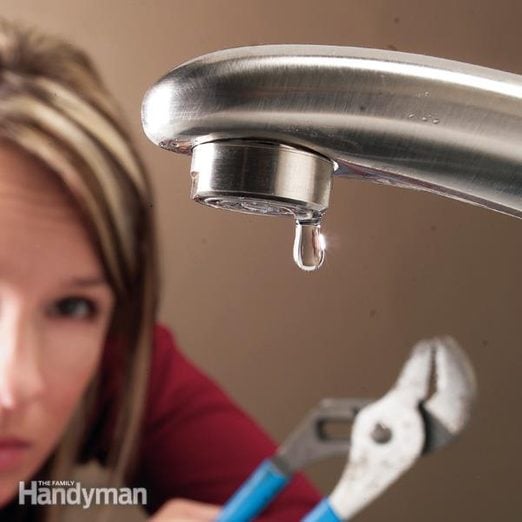How to Fix a Leaky Faucet
Updated: Feb. 15, 2024
Fix a dripping kitchen faucet with replacement parts.
An hour or less
Beginner
Less than $20
Introduction
You can fix almost any drippy single-lever kitchen faucet in about an hour. We'll show you how. The repair is a lot easier than you might think, even for a plumbing novice.Tools Required
- 4-in-1 screwdriver
- Allen wrench
- Pliers
- Slip joint pliers
Materials Required
- Faucet repair kit
- O-ring seals
Doing your own faucet repair may seem daunting, but once you learn the basics, modern faucets are fairly easy to repair. In fact, the hardest step to fix a leaky faucet is usually finding the right replacement parts. In this article, we’ll tell you how to find replacement parts and show you how to stop spout drips on the three main types of single-lever faucets: rotary ball, cartridge and ceramic disc. We’re showing kitchen faucets and kitchen faucet repair for a dripping faucet, but you can fix most single-lever bathroom faucets using the same procedures. We’ll also show you how to stop leaks around the base of the spout and fix leaking faucets.
The tools you’ll need for this how-to fix a leaky faucet project vary a little depending on the faucet you’re repairing. You’ll probably need an Allen wrench to remove the handle. Buy a set of small Allen wrenches and you’ll be prepared for all kinds of leaking faucets. Most repairs also require screwdrivers and a pair of large slip-joint pliers.
Editors Tip: Choosing the right faucet can be a task. Check these tips for choosing the right sink faucets!
Project step-by-step (18)
Rotary Ball Faucet Anatomy
- The diagram below shows the parts and assembly of a rotary ball faucet.
- Note: We recommend that you buy a repair kit that includes the ball, springs, seats and O-rings for the spout, as well as a small repair tool. With this kit, you’ll be prepared for almost any repair.

Loosen the Allen Screw
- Then turn off the water supply to the dripping faucet.
- Lift the handle and pry off the decorative cover to expose the Allen screw.
- Turn the screw counterclockwise until it’s loose enough to lift the handle up from the stem.
- Note: If water is leaking out around the base of the faucet handle, you may be able to fix the leak by removing the handle and simply tightening the adjusting ring slightly. Turn it clockwise with the spanner tool included in the repair kit. If the faucet drips from the end of the spout, replace the seats and springs.
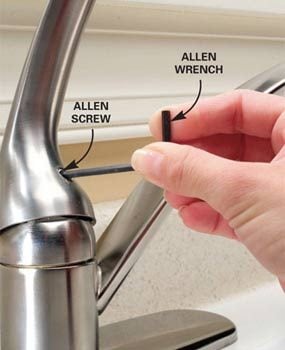
Remove the Cap
- Unscrew the cap by turning it counterclockwise with a slip-joint pliers.
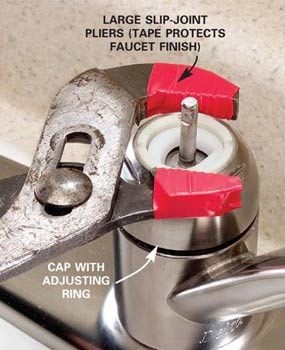
Remove the Rotary Ball
- Lift off the plastic cam and packing.
- Lift out the ball and inspect it.
- Replace the ball if it’s scratched, cracked or visibly worn.
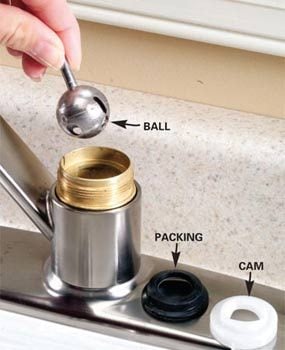
Remove and Replace the Seats and Springs
- Lift out the two rubber seats and springs with a screwdriver.
- Drop the new springs in the recesses and press the new rubber seats over the top with your fingertip.
- Align the groove in the ball with the pin in the socket and drop the ball in.
- Align the lug on the plastic cam with the notch in the valve body and set it over the ball.
- Thread on the cap with the adjusting ring and tighten it with the slip-joint pliers.
- Turn on the water to check for leaks.
- Pro tip: If water leaks from around the ball stem, use the spanner tool to tighten the adjusting ring until the leak stops.
- Replace the leaking faucet handle and you’re done.
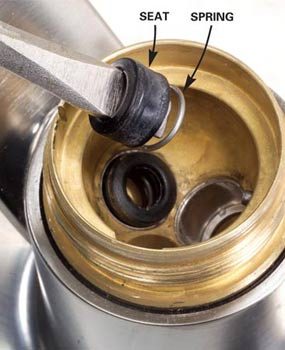
Follow These Basics for All Faucet Repairs
Before you start, examine the dripping faucet closely to determine where the water is coming from. Leaks around the base of the spout require a different repair than a drip from the end of the spout.
Then turn off the water supply to the dripping faucet. You’ll probably find shutoff valves under the sink. If those valves don’t work or if you don’t have any, you’ll have to close the main water valve to your entire home. After you turn off the water, open the faucet in the center position to relieve water pressure and make sure the water is shut off. Finally, cover the sink drain holes with strainer baskets or rags to avoid losing small parts down the drain.
Pay close attention to the order and orientation of parts as you remove them. A digital camera or video camera is handy for recording each step in case you forget. For easier reassembly, set the parts aside in the order they were removed. When all the parts are out, inspect the interior of the valve for bits of deteriorated gaskets or mineral deposits. Use a cloth or fine nylon abrasive pad to clean the surface. Loosen mineral deposits by soaking them in vinegar.
Slow water flow can be caused by plugged holes in the faucet body. Use a small screwdriver or penknife to clean them out. Before you replace worn parts and reassemble the faucet, hold a rag over the dripping faucet and open the water shutoff valve slightly to flush out debris that may have been loosened during the cleaning and inspection.
After the faucet is reassembled, open the faucet to the middle position and gradually open the shutoff valves to turn on the water. Leave the faucet open until water flows freely and all the air is out of the pipes. If the water flow through the faucet is slow, the aerator may be plugged. Unscrew the aerator and clean it out.
Take the Old Parts to the Store to Find Replacements
You’ll often find the brand name stamped on the faucet. And this information will help when it comes time to find repair parts. But in most cases, the safest bet is to take the worn parts to the store with you.
If you have a Delta or other rotary ball faucet, you’re in luck because you’ll find repair kits in most hardware stores and home centers. Cartridges and repair kits for Moen “cartridge type” faucets are also readily available. But if you have another brand or a disc-type faucet, you may have to order parts, since there are too many variations for most stores to keep in stock. It helps to know the faucet’s model name or number when searching for a replacement cartridge. Otherwise, take the cartridge with you to the store so you can match it to a photo in the parts catalog.
Plumbing supply specialists are also a good source of repair parts. If you’re having trouble finding parts, call the manufacturer of your faucet for help.
Cartridge-Style Faucet Anatomy
- Cartridge-style faucet parts and assembly.
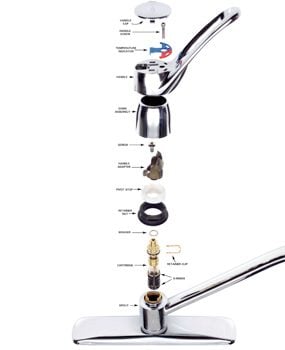
Remove the Allen Screw
- Gently pry off the handle cap with a knife.
- Turn the Allen screw counterclockwise to remove it and lift off the handle.
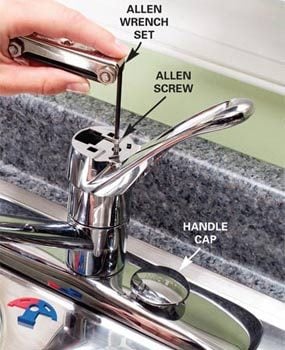
Remove the Metal Handle Adapter
- Unscrew the dome assembly under the handle.
- Unscrew the metal handle adapter and lift it off.
- Lift off the plastic pivot stop.

Take Out the Retainer Nut
- Remove the retainer nut by turning it counterclockwise with large slip-joint pliers.
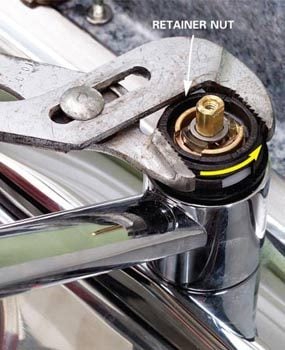
Remove the Retainer Clip
- Pry out the brass retainer clip with the tip of a screwdriver.
- Grab the clip with pliers and pull it the rest of the way out to avoid losing it.
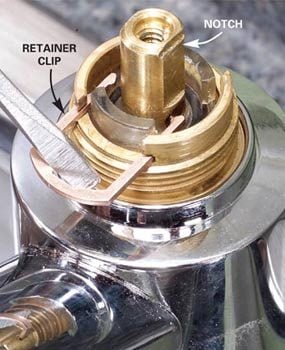
Twist Loose the Cartridge
- Loosen the cartridge by slipping the plastic spanner cap (included with the new cartridge) over the cartridge and twisting it back and forth.
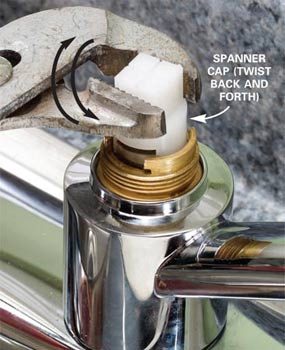
Replace Worn Parts and Reassemble the Faucet
- Grab the cartridge stem with pliers and pull it straight up and out.
- Replace worn parts.
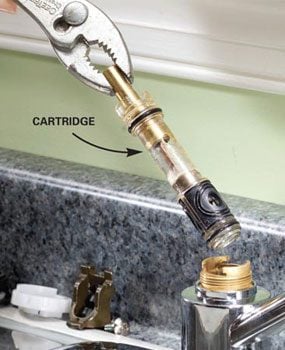
Reassemble the Faucet
- Reassemble the faucet in the reverse order.
- Pull the stem up before inserting the cartridge.
- Note: You may have to twist the cartridge slightly to line it up for the brass retainer clip.
- Use the plastic spanner cap or the tips of needle-nose pliers to rotate the cartridge.
- Slide the brass clip into the slots in the valve body to hold the cartridge in place.
- Look for the small notch on top of the stem and rotate the stem until the notch faces you.
- Install the remaining parts and reattach the handle.
- Note: The directions that come with the stem will help orient you here.
- Test the faucet.
- Note: If the hot and cold water are reversed, simply remove the handle, dome assembly and handle adapter and rotate the stem 180 degrees.
All About Cartridge-Style Faucet Repairs
Many faucet brands use a cartridge of some type. Here we show how to replace a Moen cartridge, but the process is similar for other brands. To stop drips at the spout or correct problems with hot and cold mixing, remove the cartridge and either replace the O-rings on the cartridge if they’re worn or replace the entire cartridge. Take the cartridge to the home center or hardware store to find a replacement.
Replacement cartridges for Moen faucets include a plastic spanner cap that allows you to twist and loosen the cartridge to make it easier to pull out. Don’t be surprised if the cartridge seems stuck. It may take considerable force to pull it out. Really stubborn cartridges may require the use of a special cartridge-pulling tool.
Ceramic Disc Faucet Anatomy
- Parts and assembly of ceramic disc faucets.
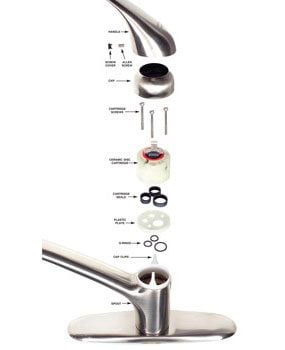
Unscrew the Handle
- Pry off the decorative screw cover with your fingernail or the tip of a knife.
- Unscrew the handle screw by turning it counterclockwise with an Allen wrench.
- Lift off the handle.
- Unscrew or unclip the cap.
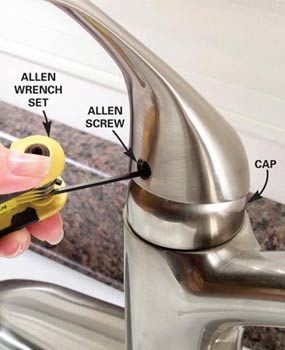
Remove the Disc Cartridge
- Remove the screws that hold the disc cartridge to the faucet body and lift out the cartridge.

Replace the Seals in the Cartridge
- Inspect the cartridge for mineral buildup and carefully clean it out.
- Then replace the rubber seals on the underside.
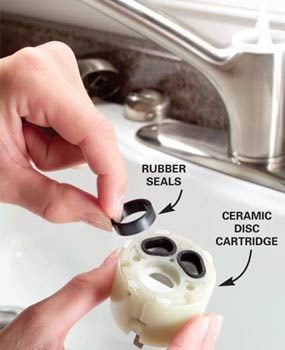
Replace the O-Ring Seals
- Lift out the plastic disc (on some faucets) and replace the O-rings under it.
- Inspect the holes in the faucet body and clean them out if they’re clogged.
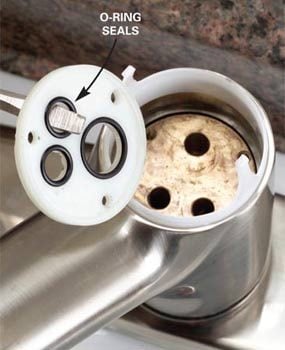
Ceramic Disc Faucets 101
Ceramic disc valves are simply another type of cartridge. Discs inside the cartridge control the water flow. This type of valve is sturdy and reliable and rarely needs fixing. In fact, many manufacturers offer a lifetime guarantee on the cartridge. If yours is damaged, check with the manufacturer to see if it’s covered by a warranty.
Leaks can result from faulty rubber seals or a cracked disc inside the cartridge. Since it’s difficult to spot a cracked disc, and disc cartridge replacements are very expensive, it’s best to start by replacing the seals and reassembling the faucet. Then if the faucet still leaks, remove the disc cartridge and take it to the store to order a replacement.
Early versions of ceramic disc faucets may be more fragile and can crack if subjected to a blast of pressurized air. That’s why it’s important to leave the faucet open as you turn the water back on. This allows air trapped in the lines to escape. When the water runs smoothly, it’s safe to turn the faucet off. Manufacturers have improved the strength of ceramic discs on newer faucets to withstand air blasts, as well as abrasive debris that may get dislodged from the inside of pipes.
Repair a Spout Leak
- Remove the handle and cartridge.
- Twist and pull up on the spout to remove it and expose the O-ring seals.
- Pro tip: The diverter valve controls water to the sprayer. Their appearance varies considerably among brands, but you’ll usually find them under the spout. If your sprayer isn’t working properly, first clean it in vinegar or simply replace it. If this doesn’t work, the diverter valve may be clogged. If it doesn’t simply pull out, contact the manufacturer or ask a knowledgeable salesperson for help with cleaning it.
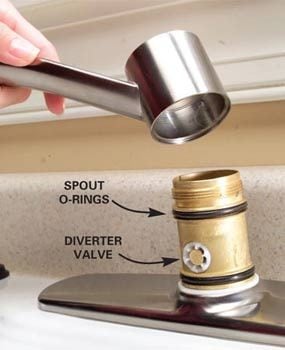
Replace the O-Rings
- Slip the tip of a screwdriver under the O-rings to slide them out of the groove.
- Install the new O-rings and lubricate them with plumber’s grease.
- Reinstall the spout.
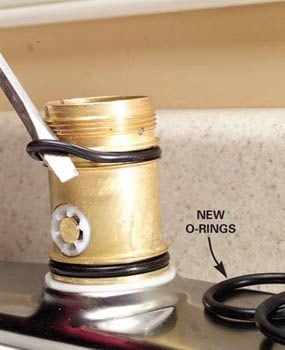
Leaky Spout Basics
Leaks around the base of the spout are caused by worn O-rings located under the spout. All that’s usually required to access these O-rings for replacement is to wiggle and pull up on the spout to remove it.
Depending on the dripping faucet, you’ll also have to remove the handle and other parts to access the spout. Be persistent. The spout may be a little stubborn. Spout O-ring kits are available for many faucets, or you can take the old O-rings to the hardware store or plumbing supply store and match them up with new ones. Remember to pick up a small toothpaste-type tube of plumber’s grease while you’re there.
